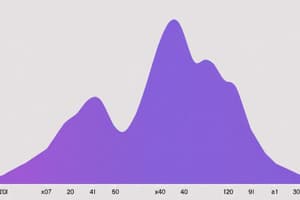Podcast
Questions and Answers
What should be the sum of the relative frequencies of IQ scores if percentages are used?
What should be the sum of the relative frequencies of IQ scores if percentages are used?
100%
What should be the sum of the relative frequencies of IQ scores if proportions are used?
What should be the sum of the relative frequencies of IQ scores if proportions are used?
1
What is the class width calculated from two consecutive lower class limits?
What is the class width calculated from two consecutive lower class limits?
subtracting a lower class limit from the next consecutive lower class limit
What is the class midpoint calculated from the lower and upper class limits?
What is the class midpoint calculated from the lower and upper class limits?
What are sample values that lie very far away from the majority of the other sample values called?
What are sample values that lie very far away from the majority of the other sample values called?
What helps us understand the nature of the distribution of a data set?
What helps us understand the nature of the distribution of a data set?
Which characteristic of data measures the amount that the data values vary?
Which characteristic of data measures the amount that the data values vary?
In a _______ distribution, how is the frequency of a class expressed?
In a _______ distribution, how is the frequency of a class expressed?
Flashcards are hidden until you start studying
Study Notes
Relative Frequency Distribution
- The sum of relative frequencies using percentages must equal 100%.
- When using proportions, the total should equal 1.
Class Characteristics in Frequency Distributions
- Class Width: Calculated by subtracting a lower class limit from the next consecutive lower class limit. Example: For classes 55-59 and 60-64, width = 60 - 55 = 5.
- Class Midpoint: Found by averaging lower and upper class limits. For example, the midpoint of 55-59 is (55+59)/2 = 57.
- Class Boundaries: Determined by averaging the upper limit of one class with the lower limit of the next class. For instance, for the class 59-60, boundary = (59+60)/2 = 59.5.
Data Variation and Distribution
- Variation: Measures how much data values differ from one another, indicating the extent of variability in the dataset.
- Outliers: Sample values that are significantly distant from the rest of the data, potentially affecting analysis.
Understanding Distributions
- Frequency Distribution: A tool used to analyze the characteristics of a dataset and visualize how data points are distributed across different classes.
- Relative Frequency Distribution: Converts the frequency of each class into proportions or percentages to facilitate comparison among different classes.
Studying That Suits You
Use AI to generate personalized quizzes and flashcards to suit your learning preferences.




